Jan-Erik Lane1, Florence Dieterlen2
1Public Policy Institute, Belgrade, Republic of Serbia
2Independent Scholar, Geneva
Correspondence to: Jan-Erik Lane, Public Policy Institute, Belgrade, Republic of Serbia.
| Email: |  |
Copyright © 2017 Scientific & Academic Publishing. All Rights Reserved.
This work is licensed under the Creative Commons Attribution International License (CC BY).
http://creativecommons.org/licenses/by/4.0/

Abstract
Time has come to move from the negotiating stage to the operational one. The COP23 in the fall must clarify how the Super Fund will be set up and become operative. The achievement of GOAL I and GOAL II are now on the agenda for all countries that signed the Paris Treaty. Thus, time has come for the social sciences to analyse the COP21 process in each nation and deliver efficiency recommendations. Economist Stern warned in 2007 against the biggest externality in the history of mankind. Now, he asks: “What are we waiting for? (Stern, 2015). Reply: Actions, not merely talk.
Keywords:
COP23, UNFCCC, Decarbonisation, CO2 – temperature rise, Solar power parks
Cite this paper: Jan-Erik Lane, Florence Dieterlen, Anti-Global Warming Strategy, World Environment, Vol. 7 No. 2, 2017, pp. 42-48. doi: 10.5923/j.env.20170702.02.
1. Introduction
Interstate coordination has been successful in the so-called COP21 Treaty by the UNFCCC in Paris 2015, having more than 190 signatories and ratified by more than 55 states. It is thus valid Public International Law, obliging the member states of the UN to start decarbonizing. It was a great achievement in states’ collaboration to reach this Treaty after so many years of meetings – transaction cost heavy.However, goals are more ideas, wishes, plans, etc. - about future development, i.e. hopes in the minds of governments and the public. Now comes the implementation stage, where means have to be elaborated that really promotes the goals. This is for the fall meeting of the UNFCCC, the COP23 in Bonn. The COP21 objectives are:- GOAL I: halting the increases in CO2:s definitely by 2020;- GOAL II: reducing by 2030 CO2 emissions by 30-40 per cent in relation the 2005 baseline;- GOAL III: full decarbonisation by 2070-80, or at least a very large reduction in the use of fossil fuels.Today, things stand as follows with regard to these key GOALS I, II and III, namely that a minority fulfills GOAL I, no country fulfills GOAL II and certainly not GOAL III. The direct target of this unique form of grand scale government coordination is the immense increase in energy consumption of fossil fuels the recent 30 years. The indirect target of the UNFCCC is the equally sharp rise in greenhouse gases, especially CO2 emissions. Table shows the total energy consumption in 2015, which increased only by 1 per cent in 2016.Table 1 shows what has to change in the course of 10-12 years. The part of fossil fuels must be pushed back about 30 per cent, to be replaced by renewables and atomic power. The elimination preferred is to take away coal.Table 1. Energy consumption 2015 (Million Tons of oil equivalent)
 |
| |
|
This is the global picture. Each country has its energy profile that varies much between countries, as some rely almost to 100 per cent upon fossil fuels whereas a few others are below 50 per cent. Many very poor countries rely much upon wood coal.
2. The CO2 Emissions and Climate Change
One may attempt to calculate exactly how increases in greenhouse gases impact upon temperature augmentations. Take the case of CO2s, where a most complicated mathematical formula is employed:(1) T = Tc + Tn, where T is temperature, Tc is the cumulative net contribution to temperature from CO2 and Tn the normal temperature;But when it comes to methane, it is not known whether the tundra will melt and release enormous amounts. But methane does not stay in the atmosphere long, like CO2s. For the other greenhouse gases, there is no similar calculation as for the CO2s: If humans could eat less meat from cows, it would mean a great improvement, as more than a billion cows emit methane. Food from chicken should replace beef meat and burgers. The general formula reads:(2) dT = λ*dF, where ‘dT’ is the change in the Earth’s average surface temperature, ‘λ’ is the climate sensitivity, usually with degrees Celsius per Watts per square meter (°C/[W/m2]), and ‘dF’ is the radiative forcing.To get the calculations going, we start from lambda between 0.54 and 1.2, but let's take the average = 0.87. Thus, we have the formula (Myhre el al, 1998):Formula: 0.87 x 5.35 x ln(C/280).Figure 1 shows how CO2 emissions may raise temperature to 4-5 degrees, which would be Hawking’s worst case scenario.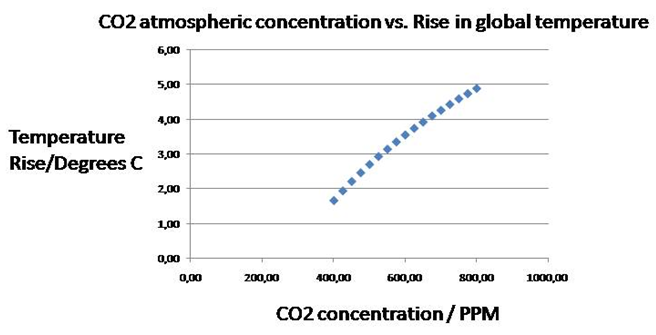 | Figure 1. CO2s and temperature rise in CELCIUS |
No one knows where the critical temperature rise occurs, i.e. from which Celsius degree global warming becomes “irreversible”, to use Stephen Hawking’s expression. It could be as low as + 2 Celsius or as high as +5 Celsius.
3. Global Warming Theory (GWT): Structure and Evidence
The most recent addition to GWT is Stephen Hawking’s ominous prediction about irreversibility. GWT has been known for some 200 years, but never harboring such dramatic hypotheses. French mathematician Joseph Fourier discovered global warming in the early 19th century looking at its contribution to warming a too cool planet Earth. But the negative theory was developed by Swedish chemist Arrhenius around 1895, focusing on the risk of overheating the planet Earth. He calculated that a doubling of CO2 ppm would be conducive to a 5 degree increase in global average temperature, which is not too far off the worst case scenario for the 21rst century, according to UN expertise now. Not until Stephen Schneider published Global Warming in 1989 did the theory receive wide attention with his journal Climate Change, no doubt strengthened by the work of Keeling in measuring CO2 ppm globally. Moreover, techniques for viewing the CO2 layer were developed, increasing the attention to climate change. Now, the UN reacted with creating a few bodies to look into the changes going on, one of which was the COP framework. One may say that GWT comprises a number of hypotheses with one theoretical core model in the natural sciences, and that it thus is well integrated in a web of beliefs.Evidence: a) Melting of polar ice massively: b) Retraction of glaciers globally; c) Huge land losses along the costs (Bangladesh); d) Too high temperatures for men and women to work outside (South Asia); e) Food production decline (Africa); f) Fish harvest decrease (Atlantic ocean, Pacific Ocean); g) Droughts and starvation (South Asia); h) Lack of fresh water supply (Latin America); i0 Drying up of rivers, affecting electricity supply (Latin America, South Asia, East Asia); j) Ocean acidification and species extinction (Australia); k) Highly volatile climate with giant forest fires, storms, rainfall and tornados with tremendous damages (America, Sri Lanka, China, Australia)); l) Deforestation and desertification (Africa, Indonesia, South Asia).The theory of GWT in the social sciences is much contested and less developed, reflecting the differences of opinion in Skeptical Science against Science CO2 on their respective websites.
4. Policy Implementation: Grand Management Tasks
The contribution of the social sciences to GWT may be divided into two very different parts.a) Part One: Negation of GWTSome social scientists have argued forcefully that GWT in particular and environmentalism in general is mere politics. Unfounded, GWT and environmentalism is in reality an attack upon the system prevailing, i.e. the capitalist market economy with all its injustices and exploitation. Aaron Wildavsky (1997) saw GWT as “Mother of all environment scares”. Julian Simon (2002) rejected the thesis that natural resources were becoming scarce in a general ecology crisis. And Bjorn Lomborg (2003, 2007) carried the message further asserting the global environment faced few problems and that we should also “COOL It”. I believe that this message is now outdated.b) Part Two: COP21 Problems in the FutureThrough the COP21 Treaty, some 190 countries have self-obliged themselves to decarbonisation in this century. It is to be done in steps: GOAL I, II and III. But how? Can such an enormous set of tasks really be accomplished, a total energy transformation where energy consumption is vital to human needs and the global economy? Two model humans, men and women, deny that the fulfilment of COP21 is feasible. Both refer to the rationality of human behavior, albeit in very different ways.i) Bounded rationalityThe most influential social scientist ever, Max Weber from Freiburg and Heidelberg, stated in a famous passage the following about means and ends in human behavior:“Any thoughtful reflection on the last elements of meaningful human activity is first of all bound to the categories of 'ends' and 'means'”. (Weber, 1922)Weber regarded the Western civilization as basically founded upon means-end rationality, or technical calculation, in both state and market. Herbert Simon developed his bounded rationality theory by emphasizing the cognitive limitations of men and women. He devoted much of his scholarship to criticize the relevance of the neo-classical decision-making model in economics to private management and public administration (Simon, 1996). In government and big firms, decisions could not meet all the requirements of full or completely comprehensive rationality. Instead, decision-making just “muddles through”, as C. Lindblom states, following H. Simon. Not all means were known, not all their probabilities could be stated, and not all goals were taken into account – bounded rationality, i.e. incomplete marginal decision-making.Wildavsky took up marginalism or incrementalism, applying it first to budget making and then to policy implementation. When the national government decides about policies, how can regional or local governments implement these? Due to cognitive limitations and the rapidly changing situation, regional and local governments may reject the means and ends of the national government, and try other implementation themselves (Pressman and Wildavsky, 1973, 1984). Policy identity would entirely lose due to space and time.The same warning – Wildavsky’s hiatus – applies to the implementation of the COP21 Treaty goals I, II and III.ii) Game theory: defectionIn game theory, we are back to the assumption of full rationality in behavior, meaning complete information and transitive preferences. In reality, the implementation of COP21 Treaty is interaction between the member states in this club, a common pool regime (CPR). The threat to this global CPR is reneging, which one big partner already has done. Turkey may follow suit and perhaps also Australia. The relevant game is the PD game (prisoner’s dilemma):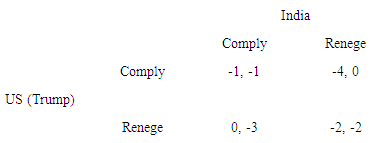 If the US and India comply, they pay 1 billion for instance for energy transformation. Reneging is better, as they pay 0. But when both defect, the costs of damages from climate change increases. The paradoxical outcome is the Nash equilibrium: -2, -2, although it is rational foolishness. The governments should coordinate upon Pareto optimality: -1, -1, but this requires promises, which will be cheated upon, as Hobbes emphasized already 1651.It has been suggested that voluntary cooperation leads to the Pareto optimal outcome when the game is played several time, sequentially repeated (Axelrod, 1984). Thus, a replay three times could give -3, -3 instead of defection: -6, -6. This insight formed a basis for Elinor Ostrom’s (1990) theory of CPRs, handling externalities by means of non-state intervention. However, Axelrod’s solution holds only for infinite games, but all CPR are finite. The sub game perfect Nash equilibrium to a repeated PD game in finite form is: defection –the principle of backwards induction.Thus, one may safely conclude that the entire COP21 goals implementation harbors lots of reneging opportunities, from funding to planning and execution as well as management. The only remedy is selective incentives, meaning that countries complying receive financial assistance – side payments. This is the real reason of the Super Fund. What, more precisely, is involved in a major comprehensive energy transformation, from fossils to for instance solar parks?
If the US and India comply, they pay 1 billion for instance for energy transformation. Reneging is better, as they pay 0. But when both defect, the costs of damages from climate change increases. The paradoxical outcome is the Nash equilibrium: -2, -2, although it is rational foolishness. The governments should coordinate upon Pareto optimality: -1, -1, but this requires promises, which will be cheated upon, as Hobbes emphasized already 1651.It has been suggested that voluntary cooperation leads to the Pareto optimal outcome when the game is played several time, sequentially repeated (Axelrod, 1984). Thus, a replay three times could give -3, -3 instead of defection: -6, -6. This insight formed a basis for Elinor Ostrom’s (1990) theory of CPRs, handling externalities by means of non-state intervention. However, Axelrod’s solution holds only for infinite games, but all CPR are finite. The sub game perfect Nash equilibrium to a repeated PD game in finite form is: defection –the principle of backwards induction.Thus, one may safely conclude that the entire COP21 goals implementation harbors lots of reneging opportunities, from funding to planning and execution as well as management. The only remedy is selective incentives, meaning that countries complying receive financial assistance – side payments. This is the real reason of the Super Fund. What, more precisely, is involved in a major comprehensive energy transformation, from fossils to for instance solar parks?
5. COP21 Energy Transformation: A Model Example
Consider now Table 2, using the giant solar power station in Morocco as the benchmark – How many would be needed to replace the energy cut in fossil fuels and maintain the same energy amount, for a few selected countries with big CO2 emissions?Table 2. Number of Ouarzazate plants necessary in 2030 for COP21’s GOAL II: Global scene (Note: Average of 250 - 300 days of sunshine used for all entries except Australia, Indonesia, and Mexico, where 300 - 350 was used)
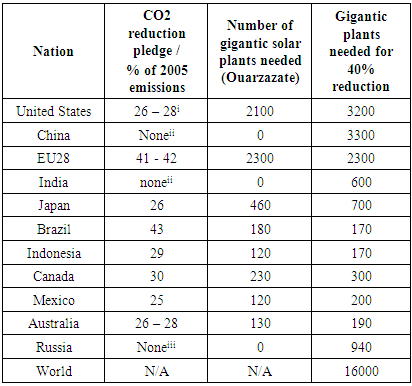 |
| |
|
If countries rely to some extent upon wind or geo-thermal power or atomic power, the number in Table 2 will be reduced. The key question is: Can so much solar power be constructed in some 10 years? Thus, the COP23 should decide to embark upon an energy transformation of this colossal size.Solar power investments will have to take many things into account: energy mix, climate, access to land, energy storage facilities, etc. They are preferable to nuclear power, which pushes the pollution problem into the distant future with other kinds of dangers. Wind power is accused to being detrimental to bird life, like in Israel’s Golan Heights. Geo-thermal power comes from volcanic power and sites. Let us look at the American scene in Table 3.Table 3. Number of Ouarzazate plants necessary in 2030 for COP21’s GOAL II: American scene (Note: Average of 250 - 300 days of sunshine per year was used for Canada, 300 – 350 for the others)
 |
| |
|
It has been researched has much a climate of Canadian type impacts upon solar power efficiency. In any case, Canada will need backs ups for its many solar power parks, like gas power stations. Mexico has a very favourable situation for solar power, but will need financing from the Super Fund, promised in COP21 Treaty. In Latin America, solar power is the future, especially as water shortages may be expected. Chile can manage their quota, but Argentine needs the Super Fund for sure. Table 4 has the data for the African scene with a few key countries, poor or medium income.Table 4. Number of Ouarzazate plants necessary in 2030 for COP21’s GOAL II: African scene (Note: Average of 300 - 350 days of sunshine per year was used)
 |
| |
|
Since Africa is poor, it does not use much energy like fossil fuels, except Maghreb as well as Egypt plus much polluting South Africa, which countries must make the energy transition as quickly as possible. The rest of Africa uses either wood coal, leading to deforestation, or water power. They can increase solar power without problems when helped financially.Table 5 shows the number of huge solar parks necessary for a few Asian countries. The numbers are staggering, but can be fulfilled, if turned into the number ONE priority. Some of the poor nations need external financing and technical assistance.Table 5. Number of Ouarzazate plants necessary in 2030 for COP21’s GOAL II. Asian scene (Note: Average of 250 - 300 days of sunshine was used for Kazakhstan, 300 - 350 days of sunshine per year for the others)
 |
| |
|
Finally, we come to the European scene (Table 6), where also great investments are needed, especially as nuclear power is reduced significantly and electrical cars will replace petrol ones, to a large extent.Table 6. Number of Ouarzazate plants necessary in 2030 for COP21’s GOAL II: European scene (Note: Average of 250 - 300 days of sunshine per year was used)
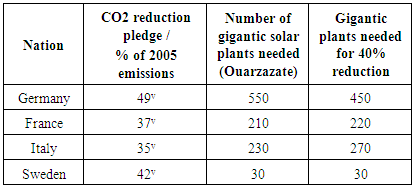 |
| |
|
Note: i. The United States has pulled out of the deal ii. No absolute targetiii. Pledge is above current level, no reductioniv. Upper limit dependent on receiving financial support v. EU joint pledge of 40% compared to 1990
6. Implementation or Management Tasks Ahead
The COP23 meeting in the fall in Bonn faces the enormous challenge of making its goals, especially GOAL I and GOAL II operational. This involves setting a joint international-national management or implementation center to engage in planning:a) What incentives to employ for decarbonisation?b) How to phase out coal as soon as possible?c) How to stop the use of wood coal in poor countries?d) How to replace fossils with a mix of renewables like solar and wind power plus geo-thermal power as well as maybe atomic energy?e) How is the construction of facilities be organized?f) The Super Fund: funding, budgeting, oversight?g) How will international governance cooperate with national policy-making, implementation and markets?h) Can the global supply of renewable power installations be enough to meet an enormous increase of demand?i) How to control goal attainment and honesty in performance with minimization of embezzlement and other forms of cheating?We are back to H. Simon’s bounded rationality. To implement or manage such a global revolution must be done in a piecemeal fashion, trial and learning, mistakes and redoing. But the UNFCCC must stop talking and start doing CO2 reduction.
7. Conclusions
Once the social sciences take on the huge research task of understanding the conditions for fulfillment of the COP21 Treaty, they will encounter lots of opportunistic behavior, attempts at reneging and a lack of clarity about achievements. But to job must be done to avoid one and for all the Stephen Hawking’s warning of global warming irreversibility. It will not be easy, as Ramesh for instance says that India cannot abstain from fossils, even stone coal or wood coal, unless massive support is forthcoming.The global situation with regard to the greenhouse gases appears from Figure 2, where the economic expansion, measured by the GDP, is accompanied by an inexorable growth in GHGs. This trend must be halted and reversed, as otherwise the 21st century will be the greenhouse century of mankind, as Stephen Schneider warned already 1989. There are several greenhouse gases, but the two biggest are the CO2s and methane. The UNFCCC has concentrated upon halting and reducing carbon dioxide, but now we are about to face a methane threat. Table 6 shows that methane is growing faster than CO2.Figure 3 displays the explosive increase in methane emissions, the consequenecs of which are far from fully known.The threat from global warming due to methane must be taken most seriously, as methane may be released by the now accelerating melting of the permafrost. The UNFCCC must start paying more attention to other GHGs than only the CO2s. It seems that the global picture in Diagram 1 must now be revised to take accelerating methane emissions into account. It may come as a global warming shock. | Figure 2. Global Link: GDP-GHC Globally: y=0.85x, R2=0.80 (Source: World Bank Data Indicators) |
Table 6. GHC minus CO2s
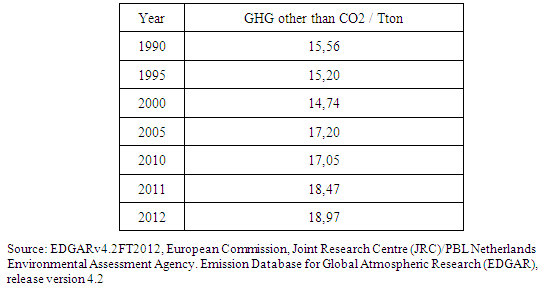 |
| |
|
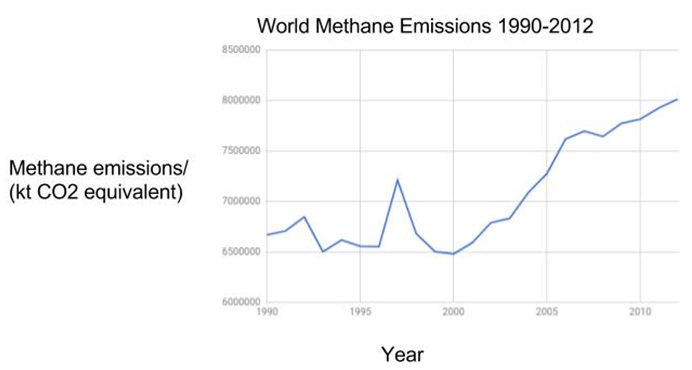 | Figure 3. Methane emissions (Source: World Bank Data Indicators) |
References
| [1] | Paris 2015: Tracking country climate pledges. Carbon Brief, https://www.carbonbrief.org/paris-2015-tracking-country-climate-pledges. |
| [2] | EDGAR v 4.3.2, European Commission, Joint Research Centre (JRC)/PBL Netherlands Environmental Assessment Agency. Emission Database for Global Atmospheric Research (EDGAR), release version 4.3.2. http://edgar.jrc.ec.europe.eu, 2016 forthcoming. |
| [3] | CO2 Emission Reduction With Solar http://www.solarmango.com/in/tools/solar-carbon-emission-reduction. |
| [4] | World Bank national accounts data - data.worldbank.org. |
| [5] | OECD National Accounts data files. |
| [6] | World Resources Institute CAIT Climate Data Explorer - cait.wri.org |
| [7] | EU Joint Research Centre Emission Database for Global Atmospheric |
| [8] | Research - http://edgar.jrc.ec.europa.eu/overview.php |
| [9] | UN Framework Convention on Climate Change - |
| [10] | http://unfccc.int/ghg_data/ghg_data_unfccc/time_series_annex_i/items/3814.php |
| [11] | International Energy Agency. Paris. |
| [12] | Energy Information Administration. Washington, DC. |
| [13] | BP Energy Outlook 2016. |
| [14] | EU Emissions Database for Global Research EDGAR. |
| [15] | http://edgar.jrc.ec.europa.eu/ |
| [16] | World Bank Data Indicators, data.worldbank.org |
| [17] | British Petroleum Statistical Review of World Energy 2016. |
| [18] | Axelrod, R. (1984) The Evolution of Cooperation. New York: Basic Books. |
| [19] | "Arrhenius, Svante August" in Chambers's Encyclopædia. London: George Newnes, 1961, Vol. 1. |
| [20] | Conka, K. (2015) Un Unfinished Foundation. The United Nations and Global Environmental Governance. Oxford: OUP. |
| [21] | Dutta, P.L. (1999) Strategies and games. Cambridge, MA: MIT Press. |
| [22] | Kaya, Y., and Yokoburi, K. (1997) Environment, energy, and economy: Strategies for sustainability. Tokyo: United Nations University Press. |
| [23] | Lomborg, B. (2003) The Skeptical Environmentalist. Cambridge: Cambridge U.P. |
| [24] | Lomborg, B. (2007) “Cool It”. New York: Vintage Books |
| [25] | Ostrom, E. (1990) Governing the Commons. Cambridge: Cambridge U.P. |
| [26] | Pressman, J. and A. Wildavsky (1973, 1984) Implementation. Berkeley: University of California Press. |
| [27] | Ramesh, J. (2015) Green Signals: Ecology, Growth and Democracy in India (2015). Oxford: Oxford University Press. |
| [28] | Sachs, J.D. (2015) The Age of Sustainable Development. New York: Columbia University Press. |
| [29] | Simon, J. (2002) Against the Grain. An Autobiography. Piscataway: Transaction. |
| [30] | Simon, H. (1996) Models of My Life. Cambridge: MA: MIT Press. |
| [31] | Stern, N. (2007) The Economics of Climate Change. Oxford: OUP. |
| [32] | Stern, N. (2015) What are we waiting for? Cambridge, MA: MIT Press. |
| [33] | Wildavsky, A. (1997) “Is it Really True”. Cambridge, MA: Harvard U.P. |
| [34] | Vogler, J. (2016) Climate Change in World Politics. Basingstoke: Macmillan Palgrave. |
| [35] | Myhre, G., Highwood, E.J., Shine, K.P. and Stordal, F. (1998) "New estimates of radiative forcing due to well mixed greenhouse gases", in Geophysics Research Letters, Volume 25, Issue 14: 2715–2718. |




 If the US and India comply, they pay 1 billion for instance for energy transformation. Reneging is better, as they pay 0. But when both defect, the costs of damages from climate change increases. The paradoxical outcome is the Nash equilibrium: -2, -2, although it is rational foolishness. The governments should coordinate upon Pareto optimality: -1, -1, but this requires promises, which will be cheated upon, as Hobbes emphasized already 1651.It has been suggested that voluntary cooperation leads to the Pareto optimal outcome when the game is played several time, sequentially repeated (Axelrod, 1984). Thus, a replay three times could give -3, -3 instead of defection: -6, -6. This insight formed a basis for Elinor Ostrom’s (1990) theory of CPRs, handling externalities by means of non-state intervention. However, Axelrod’s solution holds only for infinite games, but all CPR are finite. The sub game perfect Nash equilibrium to a repeated PD game in finite form is: defection –the principle of backwards induction.Thus, one may safely conclude that the entire COP21 goals implementation harbors lots of reneging opportunities, from funding to planning and execution as well as management. The only remedy is selective incentives, meaning that countries complying receive financial assistance – side payments. This is the real reason of the Super Fund. What, more precisely, is involved in a major comprehensive energy transformation, from fossils to for instance solar parks?
If the US and India comply, they pay 1 billion for instance for energy transformation. Reneging is better, as they pay 0. But when both defect, the costs of damages from climate change increases. The paradoxical outcome is the Nash equilibrium: -2, -2, although it is rational foolishness. The governments should coordinate upon Pareto optimality: -1, -1, but this requires promises, which will be cheated upon, as Hobbes emphasized already 1651.It has been suggested that voluntary cooperation leads to the Pareto optimal outcome when the game is played several time, sequentially repeated (Axelrod, 1984). Thus, a replay three times could give -3, -3 instead of defection: -6, -6. This insight formed a basis for Elinor Ostrom’s (1990) theory of CPRs, handling externalities by means of non-state intervention. However, Axelrod’s solution holds only for infinite games, but all CPR are finite. The sub game perfect Nash equilibrium to a repeated PD game in finite form is: defection –the principle of backwards induction.Thus, one may safely conclude that the entire COP21 goals implementation harbors lots of reneging opportunities, from funding to planning and execution as well as management. The only remedy is selective incentives, meaning that countries complying receive financial assistance – side payments. This is the real reason of the Super Fund. What, more precisely, is involved in a major comprehensive energy transformation, from fossils to for instance solar parks?

 Abstract
Abstract Reference
Reference Full-Text PDF
Full-Text PDF Full-text HTML
Full-text HTML





